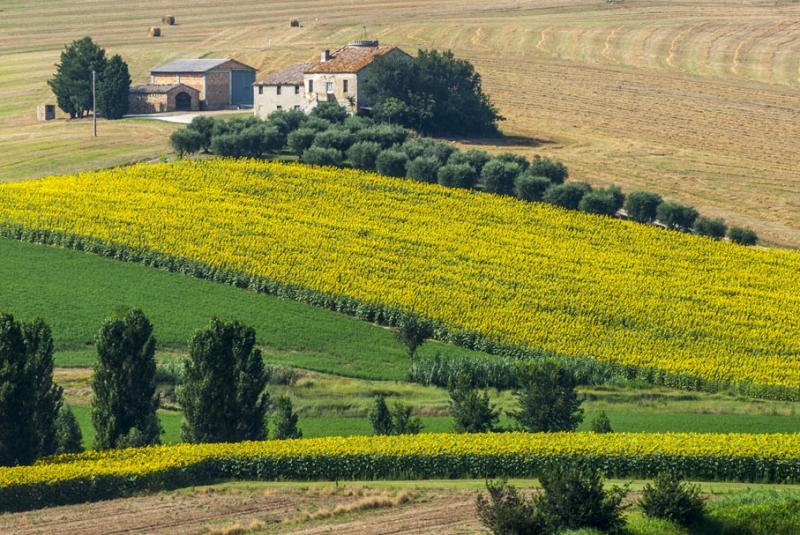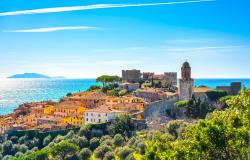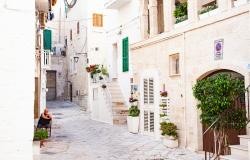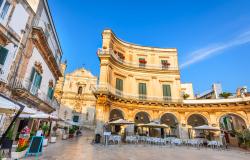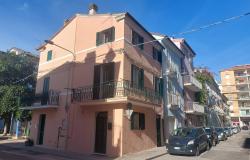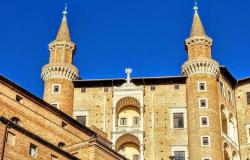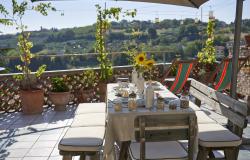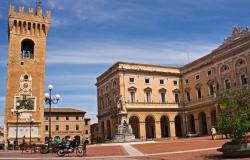Words and Pictures by Gillian Drury
Like many people, the draw of la dolce vita was firmly in our minds as we embarked on our first property search in Italy last December. For my fiancè, Jeremy, and I this would be the first of many trips to Le Marche, central Italy’s relatively undiscovered region.
Previous plans to buy a country retreat two hours from London became irrelevant when we decided that what we really wanted was to jack in our ‘desk jockey’ jobs and move to the country permanently to enjoy a more self-sufficient lifestyle.
Italy was the unanimous choice for both of us as its culture, people and love of ‘slow food’ fitted in with our plans to live a more natural and relaxed life. Le Marche became our preferred region, however, only after serious research – our previous experience of Italy being confined to business trips to its industrial cities.
The hunt begins
 Armed with the knowledge that Le Marche received less tourism than Tuscany and Umbria but that its countryside was no less breathtaking, we first viewed properties in and around San Ginesio, a beautiful medieval town surrounded by rolling countryside which provided us with a wonderful insight into Italian rural life.
Armed with the knowledge that Le Marche received less tourism than Tuscany and Umbria but that its countryside was no less breathtaking, we first viewed properties in and around San Ginesio, a beautiful medieval town surrounded by rolling countryside which provided us with a wonderful insight into Italian rural life.
As we wanted sufficient land for a small-holding we were advised that we would have to compromise our dream of a stone rustico, so we looked at several unattractive modern farm properties. Most were built in the 1950s and all were owned by elderly farmers. It saddened me to think that the children of each farm probably moved to neighbouring towns to work in offices.
One ageing farmer was keen to explain that he’d lived on the farm all his life and treated us to a 50-year old Vino Cotto made by his mother. To warn readers unaware of Vino Cotto, it is a regional speciality sweet wine made from cooked must and it packs quite a punch.
The long and winding road
 We were then shown a selection of older properties that required total restoration at central London prices. Convinced that we couldn’t afford the right property with sufficient cultivatable land in Le Marche we thought that we may have to look further south, or worse still in France.
We were then shown a selection of older properties that required total restoration at central London prices. Convinced that we couldn’t afford the right property with sufficient cultivatable land in Le Marche we thought that we may have to look further south, or worse still in France.
Now, I have nothing against the French or their beautiful country-side, but Italy has a more cerebral pull – we both look forward to understanding opera sung in its native tongue and the Italian love of simple foods cooked with home-grown organic ingredients.
A tiring and treacherous drive up to the hilly Montefeltro region to a remote B&B did little to improve our humour. Le Marche’s roads are narrow, steep and winding. We hadn’t counted on the time it would take us to drive there, or that roads would be unlit (not even by cats’ eyes) and so arrived tired and drained.
We were encouraged when Antonio’s architect wife Federica told us that we should be able to afford a traditional farm within our budget of 2200,000. Sympathetic to our plans, she was keen to help us make some useful contacts.
The bells, the bells
 On a return visit in January we were introduced to a German architect called Peter, who showed us a selection of unsuitable properties, including a mill with insufficient land and others that required too much work or sat on too steep land. Despite loving the area, especially the renaissance splendour of nearby Urbino, we decided that it was too mountainous for such novice farmers.
On a return visit in January we were introduced to a German architect called Peter, who showed us a selection of unsuitable properties, including a mill with insufficient land and others that required too much work or sat on too steep land. Despite loving the area, especially the renaissance splendour of nearby Urbino, we decided that it was too mountainous for such novice farmers.
Remembering the rolling hills surrounding San Ginesio we decided to look at the Ascoli Piceno region and conducted web searches in the southern half of Le Marche. We arranged to meet several estate agents and saw farms in Sarnano, Amandola, Ferme and Monte San Martino.
Of all the properties that we saw over a two-day period, a traditional three-storey property just outside Amandola, that came with 35 acres of land rang all the right bells.
Seal of approval
 We returned a month later with my father, a farmer of 60 years who wanted to cast a critical eye over the suitability of the land. As we drove along the winding white road toward the property on our second visit we both nodded in approval as we passed a riding school – instantly seeing the benefits of having abundant organic matter on our doorstep. My father hastily constructed some divining rods to reveal the location that suffered from poor drainage.
We returned a month later with my father, a farmer of 60 years who wanted to cast a critical eye over the suitability of the land. As we drove along the winding white road toward the property on our second visit we both nodded in approval as we passed a riding school – instantly seeing the benefits of having abundant organic matter on our doorstep. My father hastily constructed some divining rods to reveal the location that suffered from poor drainage.
We were elated when he said that this could be sorted and the land made cultivable with a couple of years hard graft. The farm has plenty of fruit and nut trees, a woodland, a flat area near the building for our vegetable patch, or orto, and a couple of steep, south-facing fields where we can plant olives and vines.
